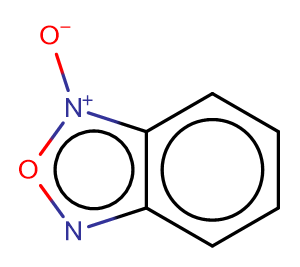
Benzofuroxan
CAS No. 480-96-6
Benzofuroxan( —— )
Catalog No. M21269 CAS No. 480-96-6
Benzofuroxan is a chemical compound.
Purity : >98% (HPLC)
 COA
COA
 Datasheet
Datasheet
 HNMR
HNMR
 HPLC
HPLC
 MSDS
MSDS
 Handing Instructions
Handing Instructions
| Size | Price / USD | Stock | Quantity |
| 100MG | Get Quote | Get Quote |


|
| 200MG | Get Quote | Get Quote |


|
| 500MG | Get Quote | Get Quote |


|
| 1G | Get Quote | Get Quote |


|
Biological Information
-
Product NameBenzofuroxan
-
NoteResearch use only, not for human use.
-
Brief DescriptionBenzofuroxan is a chemical compound.
-
DescriptionBenzofuroxan is a chemical compound.
-
In Vitro——
-
In Vivo——
-
Synonyms——
-
PathwayOthers
-
TargetOther Targets
-
RecptorOthers
-
Research Area——
-
Indication——
Chemical Information
-
CAS Number480-96-6
-
Formula Weight136.11
-
Molecular FormulaC6H4N2O2
-
Purity>98% (HPLC)
-
Solubility——
-
SMILES[O-][n+]1c(cccc2)c2no1
-
Chemical Name——
Shipping & Storage Information
-
Storage(-20℃)
-
ShippingWith Ice Pack
-
Stability≥ 2 years
Reference
1.Farias C F Massaoka M H Girola N et al. Benzofuroxan derivatives N-Br and N-I induce intrinsic apoptosis in melanoma cells by regulating AKT/BIM signaling and display anti metastatic activity in vivo[J]. Bmc Cancer 2015 15(1):807.
molnova catalog



related products
-
Remimazolam
Remimazolam is a benzodiazepine derivative drug as an alternative to the short-acting imidazobenzodiazepine midazolam, for use in induction of anaesthesia and conscious sedation for minor invasive procedures.?Remimazolam was found to be both faster acting and shorter lasting than midazolam, and human clinical trials showed a faster recovery time and predictable, consistent pharmacokinetics, suggesting some advantages over existing drugs for these applications.?
-
Glutaminase C-IN-1
Glutaminase C-IN-1 is a Glutaminase C allosteric inhibitor.
-
Losigamone
Losigamone (AO-33), an agonist of the GABA receptor, can be utilized in studies on the treatment of partial seizures.



 Cart
Cart
 sales@molnova.com
sales@molnova.com


